This post may contain affiliate links. For more information, read my disclosure policy.
Dry Measuring Cups vs Liquid Measuring Cups: when do you use each one? Why are there two kinds of measuring cups? Learn how to measure dry ingredients, how to measure wet ingredients and the best measuring cups and spoons for every ingredient.
Measuring cups are different for a reason: wet and dry ingredients go in different vessels. Make sure you know the difference so your baked goods turn out perfect every time.
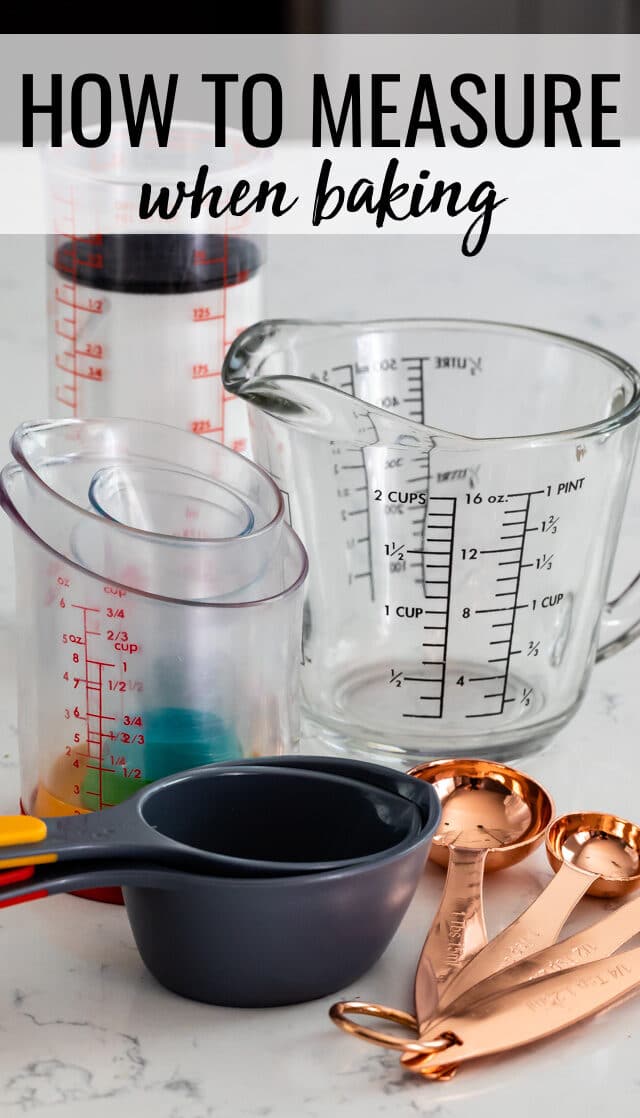
Table of Contents
Is there difference between Liquid and Dry Measuring Cups?
I’ve been baking and cooking my whole life so I take measuring cups for granted. I’ve always had different sets: one for wet and one for dry. To me, measuring ingredients for baking using the proper vessel is a no brainer. However, over the years of blogging and watching friends bake, I’ve realized that measuring ingredients isn’t something that everyone learns.
While cooking can be forgiving if you use too much of an ingredient, baking is not. Baking is a science, therefore measuring is very important. We need to know the difference between measuring cups, spoons and beakers and when to use each one.
There is a difference between different kinds of measuring cups. There are liquid measuring cups and measuring cups for dry ingredients and they should only be used for their respective items.
While both liquid and dry measuring cups have the same volume, each kind of cup is engineered to accurately measure their respective ingredients.
What is a Dry Measuring Cup?
A dry measuring cup (often sold in nested sets of 4 cups or more) is designed to fill to the brim with the dry ingredient. There is little worry about sloshing ingredients over the side when you’re measuring flour or sugar. These cups are designed to fill and level without packing (because the only ingredient you pack is brown sugar).
What is a Liquid Measuring Cup?
A wet measuring cup, on the other hand, is designed where the measurement is below the top of the cup. That way, you can fill the measuring cup to the correct measure without spilling while you transfer the ingredient to your mixing bowl.
Wet measuring cups are usually sold in cup increments (1-cup or 2-cup measures all in one, etc) or as beakers.
Measuring spoons are the only all-purpose measuring tool. You measure both wet and dry in measuring spoons, unless you have beakers with small measures on them.
**For a list of all my preferred measuring cups and spoons, see the bottom of this post.**
Knowing how to measure ingredients for baking is crucial to the outcome of your recipe.
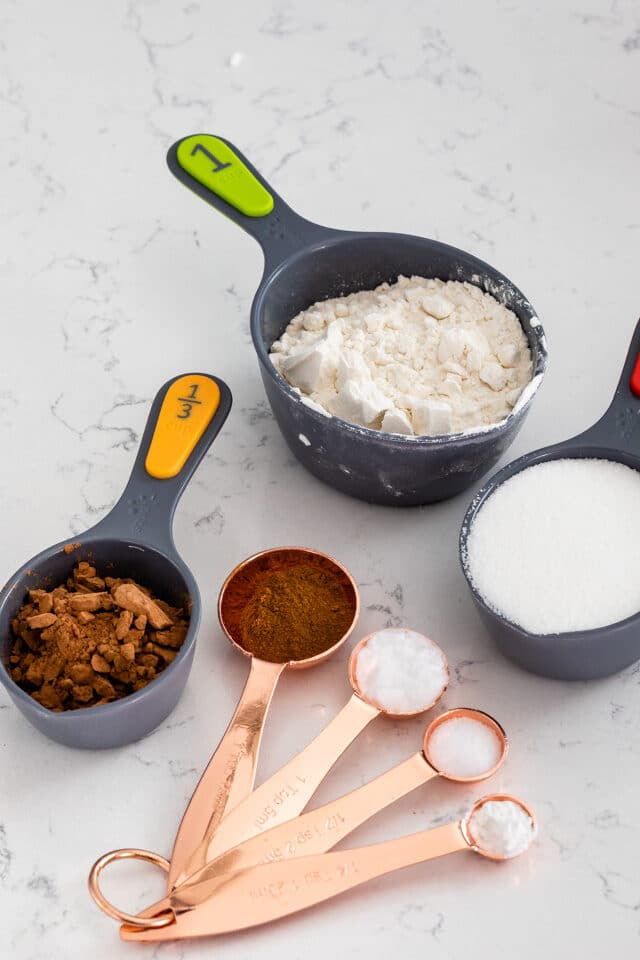
What is a dry measuring cup?
Dry measuring cups are used for measuring solid (dry) ingredients like flour, sugar, oats, or baking powder. They’re made from plastic, metal or porcelain and are sold in sets.
The standard 4 measuring cup sizes are: 1 cup, 1/2 cup, 1/3 cup and 1/4 cup. With those four cup sizes you can measure dry ingredients for any recipe.
How to use a dry measuring cup:
- Spoon or scoop ingredients into the measuring cup. Use the back of a kitchen knife or other flat surface to level off the top.
- Do not pack your flour! Learn how to measure flour the right way.
- Only pack ingredients if they say “packed”, except for brown sugar. Brown sugar is always measured packed unless otherwise specified.
Measuring spoons are used for wet or dry ingredients.
The only time it’s fine to mix wet and dry ingredient measures is when you’re using a measuring spoon.
Measuring spoons are made of metal or plastic and come in sets of 5 or 6 spoons: 1 tablespoon, 1 teaspoon, 1/2 teaspoon, 1/4 teaspoon and sometimes 1/8 teaspoon. They should also be measured and leveled.
Using a scale is the most accurate way to measure dry ingredients
Any professional will convince you that you need a scale to measure dry ingredients. While this is correct, it’s not logical for most households who have measuring cups. Most regular people have grown up measuring in measuring cups, not weighing their ingredients, and in America we don’t use the metric system, so a scale can complicate things even more.
However, if you want to be precisely accurate and are using recipes that call for ounces or grams, you’ll want to use a scale.
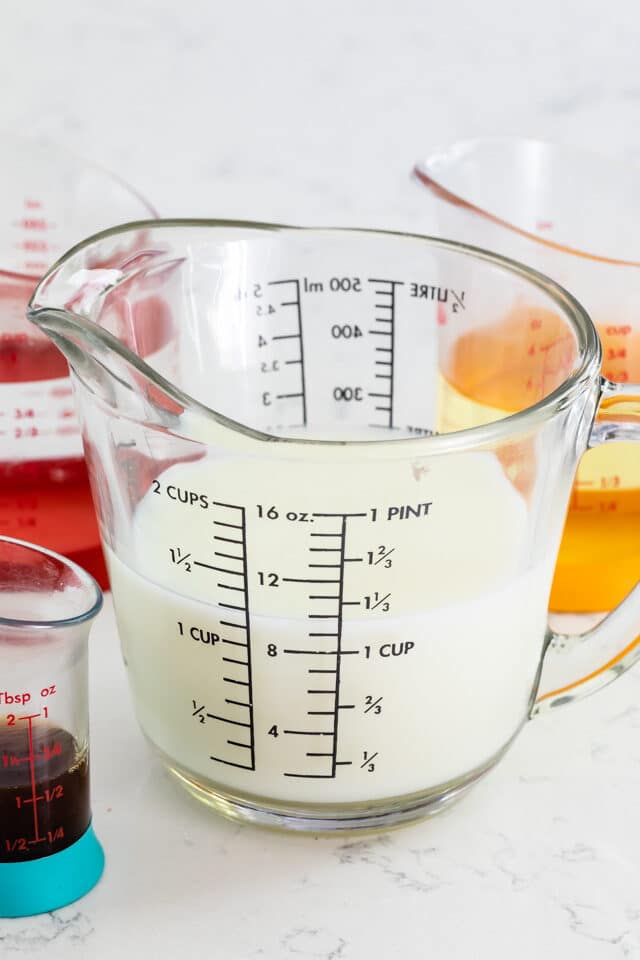
The best liquid measuring cups have a range of sizes and measuring units
A liquid measuring cup is designed to measuring the volume of liquid needed for a recipe. Liquid measuring cups come in all sizes, materials and forms. The traditional liquid measuring cup has 1/3 and 1/4 cup marks as well as ml and ounces.
Liquid measuring cups are made to fill to the measure line with a little bit of space above it so that you can get it from where you’re filling it to your mixing bowl without spilling.
I think it’s best to have a few different sizes of measuring cups (1-cup, 2-cup and a 4-cup are standard).
How to measure liquid in a measuring cup:
- Place the measuring cup on a flat surface. Add the liquid to the desired measure.
- Squat down to eye level with the measuring cup and, once the liquid stays still, make sure it is at the level of the mark you want.
- Don’t hold the measuring cup to check if it’s level: if you move your hand you won’t be able to tell.
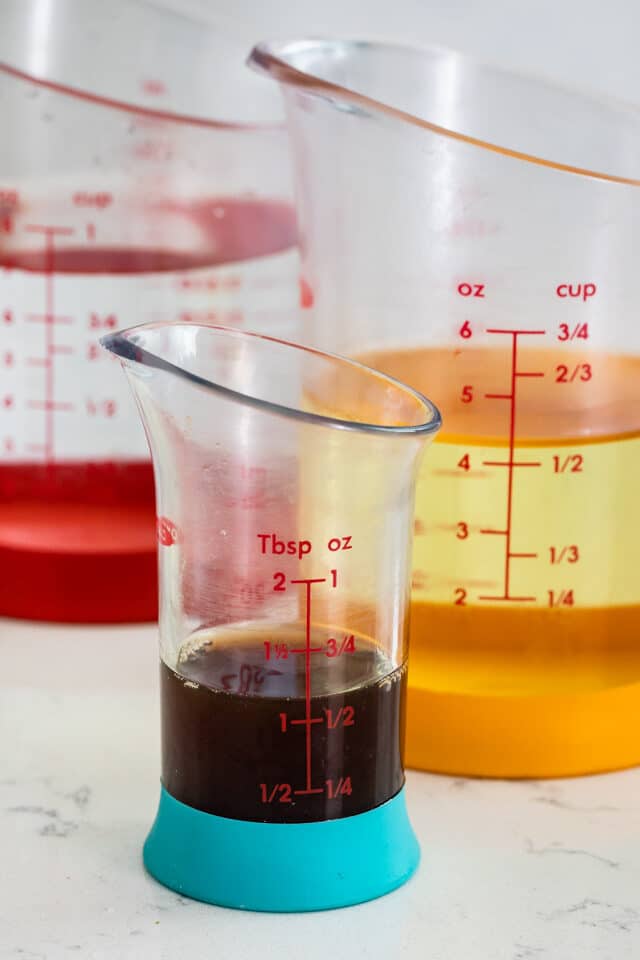
Beaker measuring cups can help you measure smaller liquid amounts.
A newer product, these beaker measuring cups are a fun way to measure liquids. You can get them up to 1-cup size, but I love using the smaller sizes in place of measuring spoons for measurements less than a tablespoon. It’s easier to measure vanilla extract and transfer it to a bowl in a beaker than a measuring spoon.
These beaker measuring cups are also nice when you’re making cocktails because you can easily measure 1 ounce of liquid.
Liquid measuring cups also make it easier to measure ounces and milliliters.
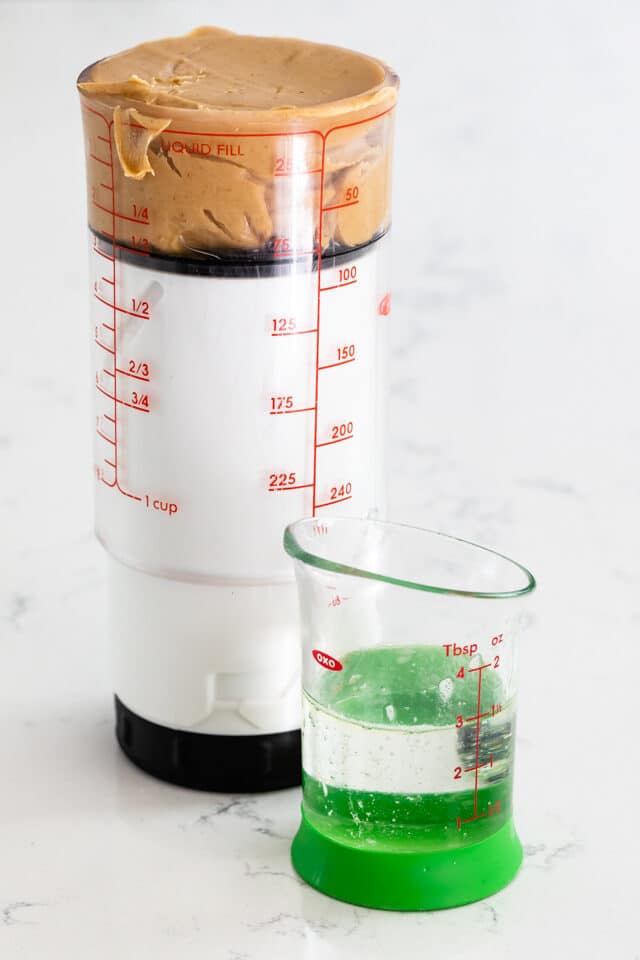
A sticky measuring cup is perfect for liquids that are more solid.
There are certain wet ingredients that are hard to measure in a traditional liquid measuring cup. Take peanut butter, for example: it’s almost impossible to measure peanut butter in a liquid measuring cup and it’s not really a dry ingredient…so what measuring cup do you use?
For things like peanut butter or yogurt or applesauce, you should use a dry measuring cup. It’s easier to measure these straight up to the top of the measuring cup and not spill it on the way to the mixing bowl. It’s much harder to measure these ingredients in a liquid measuring cup and it’s very frustrating to clean a dry measuring cup that’s had peanut butter in it.
That’s why a sticky measuring cup is the perfect vessel to measure things like peanut butter or honey or even yogurt or sour cream. These measuring cups are like a push-pop (remember those?) You measure your ingredients in the tube then push it out. Easy to measure, easy to clean.
If you don’t have a sticky measuring cup and need to measure corn syrup or honey or another sticky ingredient I have a tip for easy removal:
Spray your measuring cup with nonstick cooking spray before measuring out a sticky ingredient like honey. The sticky ingredient will pour right out of your measuring cup easily!
Using the right kind of measuring cup will ensure baking success every time.
The best liquid measuring cups:
The best dry measuring cups & spoons:
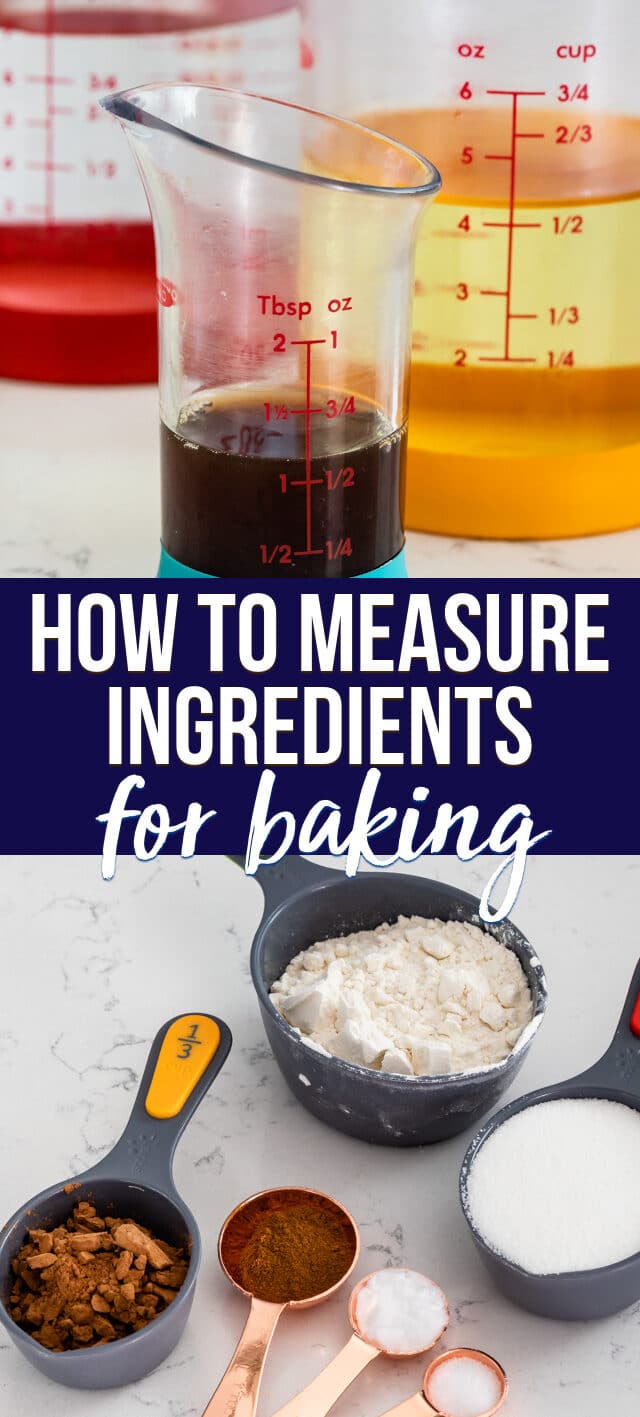
Choosing the right measuring cup is one of the most important things you’ll do when you’re baking. Make sure to use dry measuring cups for dry ingredients and liquid measuring cups for wet ingredients!
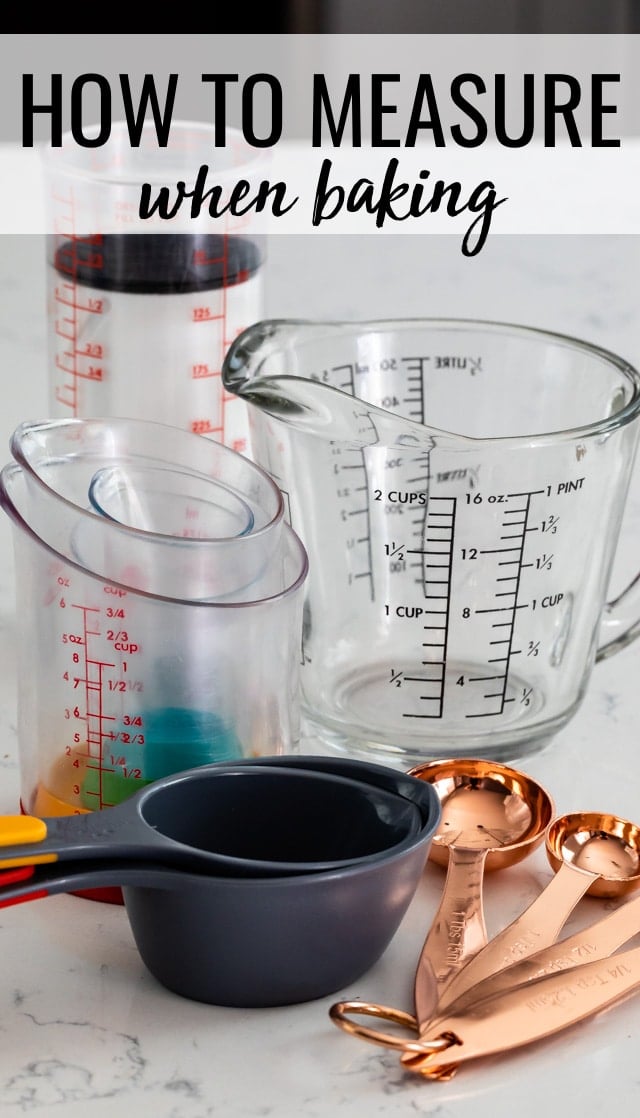
Do you wash your glass measuring cups by hand? I love these but every one I have bought in recent years except for my very oldest one (over 15yrs) the writing has come off in the dishwasher. Thinking of getting the embossed ones but they don’t stack which in my limited space is important to me.